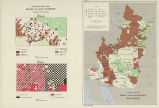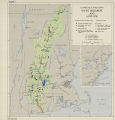| OCR Text |
farmers. But in terms of full employment (fifty 40-hour workweeks a year), forest industry in Ala- bama provides about 90,000 man-years of work- 40,000 in cutting products and hauling them to mills and 50,000 in manufacture. Mining Most of this basin lies east of the main iron, coal, and limestone deposits of Alabama which support the iron and steel industry of the Birmingham- Bessemer area. However, deposits of iron, coal, and limestone occur within the basin and some are being worked. Many of the unworked deposits may, in time, enter the Birmingham-Bessemer market. The basin also contains deposits of varying im- portance-clay, glass sand, graphite, mica, manga- nese, bauxite, barite, and marble. Some glass sand is marketed for use as foundry sand in the manu- facture of iron castings. Although deposits of other minerals have been worked, there is little sig- nificant production at this time. Tin deposits reported in Coosa County are under active exploration by the Bureau of Mines. Lig- nite deposits in Monroe and Wilcox Counties, Ala., have been considered as a possible basis for develop- ment of synthetic liquid fuels. Manufacturing Although manufacturing is relatively new in the basin, it has developed rapidly and promises to be- come of increasing importance. Between 1939 and 1947, the number of manufacturing establishments increased from 1,001 to 2,042. In the same period the number of production workers increased from 85,000 to 116,000, or 37 percent. Average increase for the United States in number of production workers was 53 percent in the same period. Industry is concentrated in the central and upper portions of the basin. Major industrial centers are Montgomery, Selma, Anniston, Gadsden, and Rome. Textile and apparel manufacture, iron and steel production and fabrication, processing of wood products, and manufacture of chemical prod- ucts are major industries. Cotton textile manufacture ranks first, and silk and rayon knitting are also prominent. Textile and apparel industries are located in or near Alex- ander City, Montgomery, Opelika, Tallassee, and Talladega, Ala., and Rome, Ga. Steel and iron mills, centered principally in Gadsden and Annis- ton, use coal and iron ore which is mined nearby. The forest lands supply raw materials for sawmills, pulp mills, and naval stores 4 plants. Processing of forest products is important throughout the basin but particularly so in the southern portion. Major chemical manufactures are fertilizers and cotton- seed oils. In addition to the recent industrial development, this area has opportunities for much greater growth with the development of its water resources. Major Basin Problems and Potentialities The major problem of the Alabama-Coosa Basin is the provision of adequate economic opportunity for its people. This basin, like much of the south- east section of the United States, is an area of low rural income. Although there has been a decrease in tenancy and increase in owner operation in the past 20 years, about two-thirds of the farm fam- ilies are still tenants or sharecroppers. Soil produc- tivity and timber resources have been seriously ex- ploited by rural people in their effort to make a living. Two broad approaches to the basic problem of the area are presented. One is to provide addi- tional employment opportunities off the farm. The other is to make possible higher income for the peo- ple who remain in agriculture by improved land use. These two changes should proceed together. The shift of people from farming to other em- ployment has started. Mechanization of farms and a change from cotton and corn to grassland and other types of farming are factors which may be expected to contribute to further dislocation of farm families and farm labor. From the stand- point of land use this trend is beneficial, but the problem of providing permanent employment for those displaced from farms remains. Opportunities to solve this problem lie in the direction of expanded industrial activity. This ex- pansion, in turn, can be stimulated and encouraged by carefully planned use of the basin's water re- sources. An abundant and reliable water supply is essential to many industrial operations, especially those in the textile, iron and steel, chemical, and paper industries. The Southern Appalachian Mountain area is the largest source of undeveloped water available south of the Great Lakes. In 4 Naval stores include turpentine and resin. 52» |


























































































































































































































































































































































































































































































































































































































































































































































































































































